The Economics and Statistics Division maintains archives of previous publications for accountability purposes, but makes no updates to keep these documents current with the latest data revisions from Statistics Canada. As a result, information in older documents may not be accurate. Please exercise caution when referring to older documents. For the latest information and historical data, please contact the individual listed to the right.
<--- Return to Archive
For additional information relating to this article, please contact:
June 28, 2023NOVA SCOTIA QUARTERLY POPULATION ESTIMATES AS OF APRIL 1, 2023 
Nova Scotia's population was 1,047,232 as of April 1, 2023. Nova Scotia's population increased by 9,450 (+0.91%) from January 1, 2023.
From January 1 to March 31, there were large contributions to population growth from immigration (+3,936) and non-permanent residents (+3,827) as well as from net interprovincial migration (+2,690). Natural change (-876) continues to put downward pressure on Nova Scotia's population as deaths outpace births. Net emigration from Nova Scotia to other countries reduced the population by a further 127.
There are seasonal patterns in quarterly population changes, particularly evident in births and migration. From January 1 to March 31, 2023, Nova Scotia posted an increase well above any other recent Q1 change.
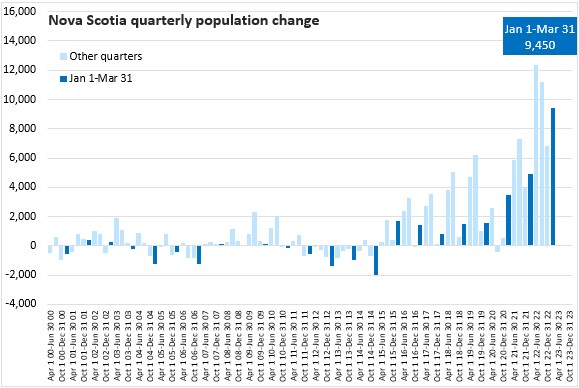
From January 1 to March 31, 2023 Nova Scotia’s population increased 0.91%, while the national population grew 0.74%. All provinces reported increasing populations. Alberta and Prince Edward Island had the fastest growth rates over this period while Newfoundland and Labrador had the slowest.
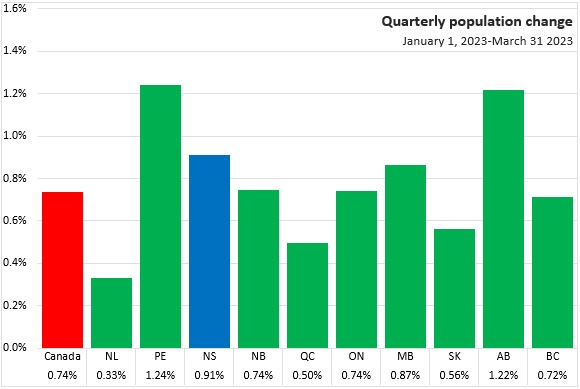
Compared with April 1, 2022, Nova Scotia's population increased by 39,872 (+3.96%). This was the fastest year-over-year growth for Nova Scotia's population for any 12-month period of the quarterly data that started in 1951. Since ending a period of population decline on April 1, 2015 Nova Scotia's population has increased by 110,961.
Over the previous 12 months, the national population grew by 3.14%. All three Maritime provinces as well as Manitoba and Saskatchewan reported their fastest year-over-year growth rates in the quarterly data that started in 1951.
Nova Scotia's year-over-year population growth was the third fastest among the provinces. Prince Edward Island (+4.61%) and Alberta (+4.46%) had the fastest growth rates over the past year. Newfoundland and Labrador (+2.04%) and Quebec (+2.09%) reported the slowest growth rates.

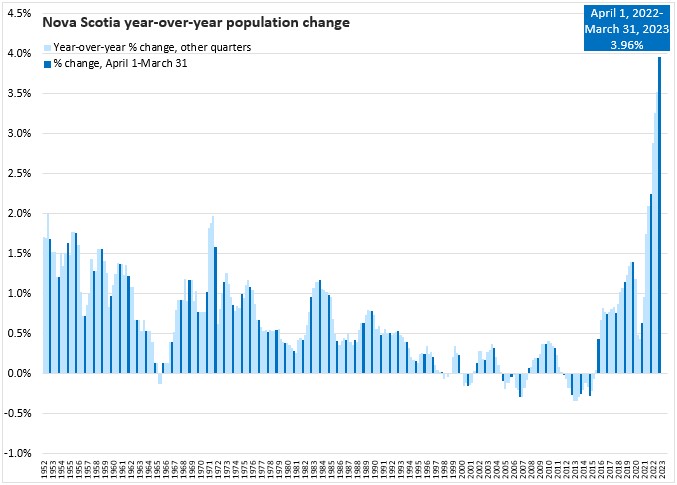
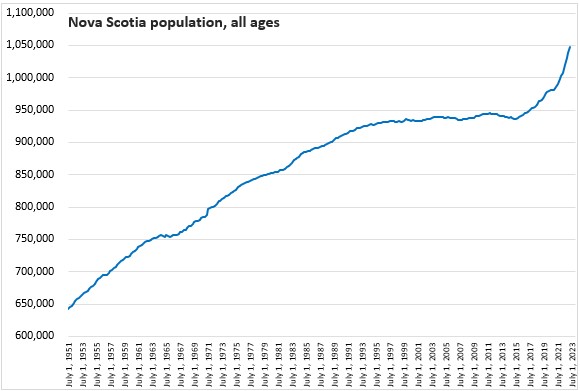
Immigration from other countries has been a strong contributor to population growth in Nova Scotia in recent years. Although the January 1-March 31 period typically sees slower immigration, there were 3,936 immigrants to Nova Scotia in the first three months of 2023. This was the second largest quarter of immigration to Nova Scotia in records dating back to 1946 (the last three months of 2021 reported more immigrants).

The net change in non-permanent residents in the province was an inflow of 3,827 from January 1 to March 31. This was the third largest net increase for non-permanent residents for any recent quarter.

Nova Scotia’s natural population change (the number of births less the number of deaths) has been negative for several years. Between January 1 and March 31 there were 2,085 births and 2,961 deaths, amounting to a natural population decline of 876.
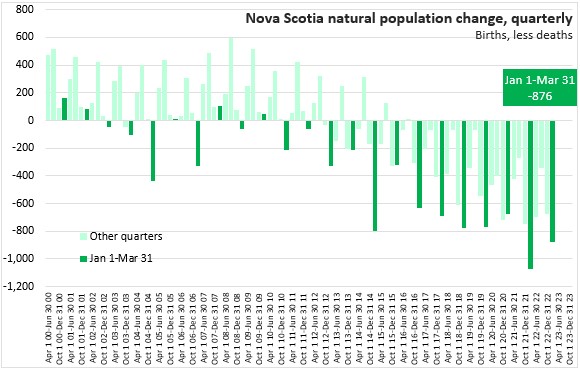
A total of 6,955 new Nova Scotians arrived in the province from other parts of Canada between January 1 and March 31. In-migration typically slows during the winter months, but in the first quarter in 2023 Nova Scotia received more in-migrants than the same period in any previous years (data series back to 1961).
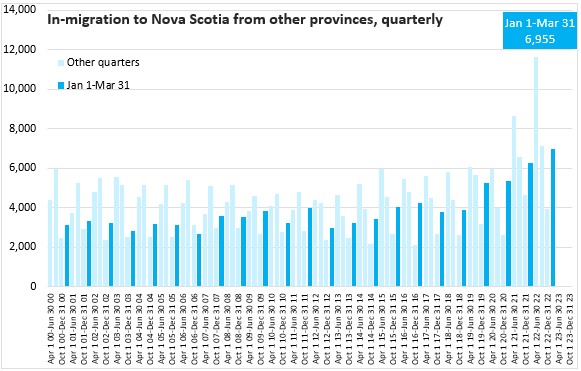
A total of 4,265 Nova Scotians left the province bound for other parts of Canada between January 1 and March 31. This was the most out-migration for the January-March period of the year since 2015.
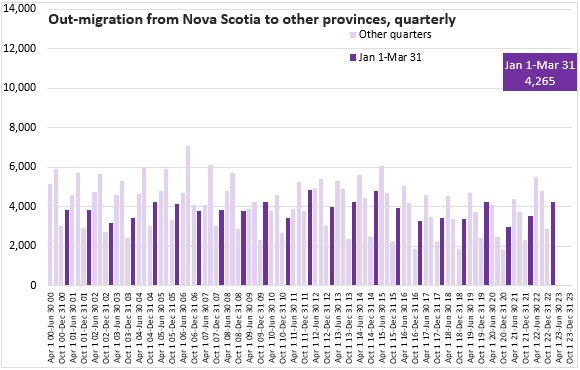
Nova Scotia's population grew by 2,690 as a result of net interprovincial migration from January 1 to March 31.

Ontario continues to account for the largest number of in-migrants to Nova Scotia. Migration from Ontario to Nova Scotia increased from 3,157 between January 1, 2022 and March 31, 2022 to 3,843 from January 1, 2023 to March 31, 2023. There were also a higher number of interprovincial in-migrants to Nova Scotia from Québec, Manitoba and British Columbia. The number of in-migrants to Nova Scotia from January 1 to March 31, 2023 decreased for all other Atlantic provinces as well as from Saskatchewan and Alberta.
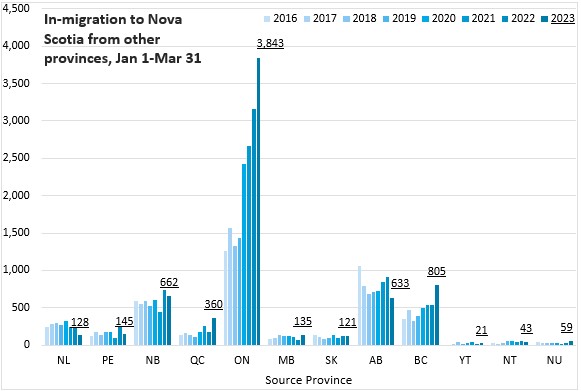
Ontario, Alberta and New Brunswick were the largest destinations for those leaving Nova Scotia between January 1 and March 31 of 2023. There was a notable increase in out-migration from Nova Scotia to Alberta during this period.
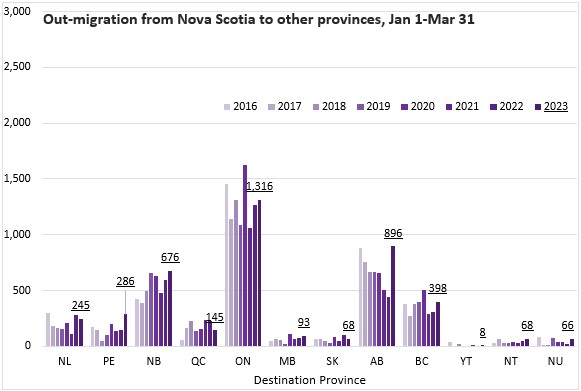
Ontario, Québec and British Columbia were the main sources of positive net interprovincial migration to Nova Scotia (with smaller contributions from Manitoba, Saskatchewan and the Yukon Territory). Net interprovincial migration with Nova Scotia was negative for the other Atlantic provinces as well as for Alberta, the Northwest Territories and Nunavut.
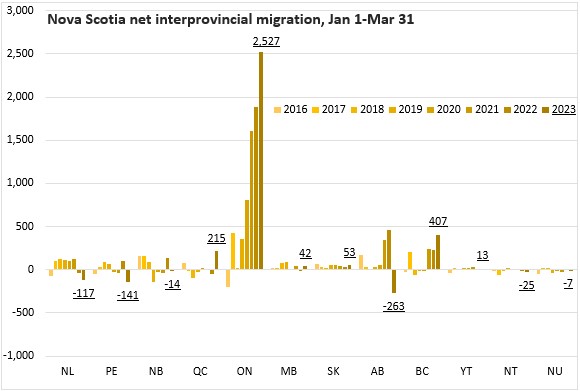
Source: Statistics Canada. Table 17-10-0009-01 Population estimates, quarterly; Table 17-10-0020-01 Estimates of the components of interprovincial migration, quarterly; Table 17-10-0040-01 Estimates of the components of international migration, quarterly; Table 17-10-0045-01 Estimates of interprovincial migrants by province or territory of origin and destination, quarterly; Table 17-10-0059-01 Estimates of the components of natural increase, quarterly
<--- Return to Archive